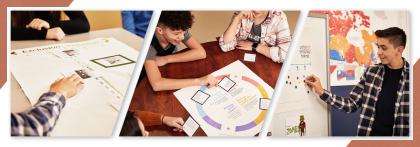
September 30 marks the National Day of Truth and Reconciliation. Elections Canada has resources for secondary schools that help students learn some historical truths and think about how they can support inclusion in their own lives.
Three Elections Canada resources feature Indigenous experiences, stories and voices:
- Voting Rights through Time explores the inclusion of First Nations peoples and Inuit in the federal right to vote.
- Civic Action: Then and Now explores how Indigenous peoples acted to secure their rights in the past to inspire action today.
- Does Voting Matter? features one Algonquin woman’s story about why voting matters to her.
Voting Rights through Time: First Nations Peoples and Inuit Case Studies
Engage your students in the history of voting rights for Indigenous peoples with Voting Rights through Time. This resource includes case studies on the history of federal voting rights for Inuit and First Nations peoples. Together, students discuss historic events and place them on an inclusion–exclusion scale. The case studies will help your students see the complexities and harms of past policies that excluded many groups, including Indigenous peoples, from voting rights in Canada. For example, students will learn that although Inuit were granted federal voting rights in 1950, about half of Inuit communities in Canada lacked voting services until 1962. They will also learn that until 1960, First Nations peoples were able to vote in federal elections only if they gave up their status and treaty rights.
The case studies also illustrate agency by Indigenous people to effect change. For example, students learn that in 1976 a new electoral district was created in what is now Nunavut and that in 1979, for the first time, all candidates in a federal riding were Inuit. Students will also learn that Tommy Prince and other First Nations veterans told a parliamentary committee in 1948 that they should have the right to vote without any conditions.
The students decide how inclusive or exclusive each event was as they complete a timeline together. This allows them to see how Inuit and First Nations peoples have unique experiences of voting rights through time. The activity raises questions for students and provides a launching point for reflection and discussions about inclusion in their own lives.
Civic Action Then and Now: Aboriginal and Treaty Rights in Canada’s Constitution
Using case studies, Civic Action: Then and Now explores successful civic actions in the past. In the case study Aboriginal and Treaty Rights in Canada’s Constitution, students learn how First Nations peoples, Inuit and Métis came together to bring about change to the Canadian Constitution in 1982. Led by George Manuel, First Nations in British Columbia rented two trains and brought 1,000 people to Ottawa to meet with parliamentarians and leaders. As a result of their actions, the Constitution now includes Section 35, which recognizes and affirms Aboriginal and treaty rights for First Nations peoples, Inuit and Métis. This movement prompted Indigenous organizations to continue working collectively to make their voices heard.
Students first watch the short video Aboriginal and Treaty Rights in Canada’s Constitution, then work in groups to sort specific actions into categories of civic action. Once they have completed the activity, students can learn more about issues that they care about and think about how they can make change happen today, tomorrow and in decades to come.
Does Voting Matter? Marcie’s story
In the learning activity Does Voting Matter?, students participate in a series of voting simulations to understand how voter turnout can affect decisions made by governments. This resource features videos of Canadians explaining why voting matters to them. In Marcie’s Story, we hear from an Algonquin woman from Kitigan Zibi. Marcie notes that her parents did not have the right to vote and shares her own experience of voting and her hope that her teenage son will exercise his right to vote. She encourages young people to ask their friends, and other people in their community, about their voting stories. The activity encourages students to reflect on their own thoughts and feelings about voting and decide for themselves, Does Voting Matter?
Including Indigenous peoples’ experiences, stories and voices while teaching about elections and democracy in your classroom can help your students understand the historical and contemporary contexts of Indigenous peoples. This can set the stage for engaging students in meaningful conversations about inclusion, not just on the National Day of Truth and Reconciliation in September, but all year long.

